Chalykoff, Dimitri & Neda.
Children: Neda, Roderick, Sanna, Nicholas.
Hearst Relatives: Bourdon (Neda), Wade (Sanna), Dr. Penu Chalykoff, Aubin.
Chalykoff, Tony & Anne.
Child: Neda.
Dimitri and Neda: What was it? Didn't I care? Or did I instinctively know that if I asked questions of the past I wouldn't get answers? Perhaps they didn't know. Now as I search through childhood memories, grasping at bits and pieces to write about my grandparents, Dimitri and Neda Chalykoff, the lack of detail is evident. Thankfully, Dan Chalykoff, son of Ted and grandson of Rod, researched the lives of the Chalykoffs at the turn of the twentieth century and lent assistance.
The Chalykoffs in Bulgaria were average-income, middle-class shopkeepers, publicans and small farmers in and around Varbitsa. They had houses in town and land outside town. Most of them were farmers, butchers, shopkeepers and bakers. It has been said that Varbitsa was known as the town of origin of half the shopkeepers in Bulgaria.
In 1907, Dimitri Chalykoff came to Canada. He had served his two years in the Bulgarian army, and there was talk of an additional two. Born in 1879, Dimitri was now twenty-eight, with a wife, Neda, and a baby daughter, also Neda. He was undoubtedly influenced by Canadian government advertisements, luring Europeans to Canada to work for two years on the railroad in exchange for citizenship and land in Northern Ontario. So many Bulgarians worked on one part of the Canadian railway line that it was named the Sov Line, after the Bulgarian general who had defeated the Turks.
Dimitri's bakery in Cochrane burned in 1916, in the fire that destroyed so much of the town. In 1912, Neda and her six-year-old daughter, Neda, emigrated to Canada. Shortly thereafter (1913), in Cochrane, a son was born, Roderick. Later, in 1914, a daughter, Sanna, was born in Montreal. A year later Nicholas was born.
By now the family was living on Simpson Avenue, in Toronto, with the children in school. Sanna and Neda went to Bishop Bethune College for girls in Oshawa, administered by the Grey Nuns of the Anglican Church. Rod attended a business school in Toronto and Nicholas an Ottawa college, where he contracted tuberculosis from a roommate. He ultimately had to have a lung removed while still in his teens.
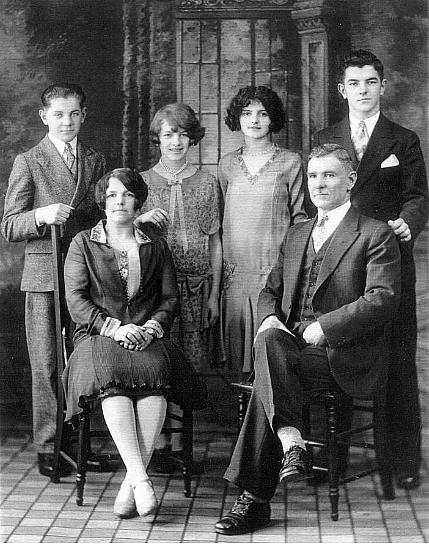
Chalykoff Family, 1928:
Front: Neda and Dimitri; Back: Nick, Sanna, Neda, Rod.
Sometime in the late 1930s, Dimitri sold the store in Hearst to Tony Chalykoff, his younger brother, and moved with Nicholas to Val d'Or, Quebec. Nick met and married Margaret, the daughter of a local undertaker. Being a devout Roman Catholic, Aunt Margaret promised God that she would take care of all the children He sent her if He would take care of Uncle Nick's fragile health. Presumably, God kept his part of the bargain, because Margaret had many children, even adopting some, and Nick lived into his nineties. From Val d'Or they moved to Wawa, opened a clothing store, and raised their large family. After retirement, Nick and Margaret moved to balmier weather in British Columbia. Many of their children still live in Wawa.
Dr. Penu Chalykoff: In 1930, an orphaned nephew, Penu Chalykoff, arrived in Canada from Bulgaria. The ship's manifest reads as follows – Surname: Chalykoff; Given Name: Penu; Age: 18; Sex: M; Nationality: Bul; Date of Arrival: 1930/04/28; Port of Arrival: Quebec; Ship: ASCANIA, Cunard.
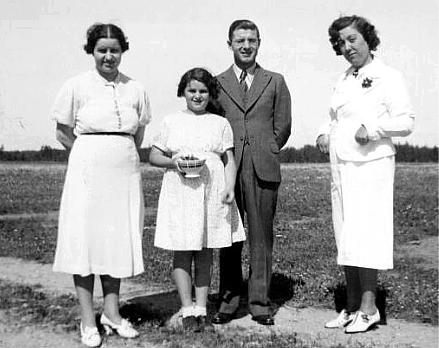
Anne Chalykoff & daughter Neda, Penu Chalykoff, Anastasia Shoppoff.
Penu was eighteen and lived with Dimitri's family in Toronto. From there he moved to Hearst, before leaving for university to become a physician. He returned to Hearst and set up a practice in the house that belonged to the Wades at 904 Prince Street. Here he met and married Ella Aubin and together they had three children – Penu, Sonja and Cyril. Naturally, Dr. Chalykoff became our family doctor.
In 1943, with no dentist in town, he extracted some of my teeth while I was unconscious from ether. In later years, when I was determined to ride a bike, I would practise on my cousin's bike on their gravel driveway. After falling repeatedly, my knees would be bleeding and pitted with stones. On one such occasion, I toddled off on my own to Dr. Penu. He gave me a jar of white paste called sulfathiazole, a handful of tongue depressors, and rolls of gauze bandages. I was to follow his instructions to pick the stones from my knees, apply the medication with a tongue depressor and wrap and tie bandages on the wounds. They healed, only to be mangled again from the next episode with the bike. We were fortunate to have him, if only for a short time. He died in 1950 at Queen's University, studying brain surgery.
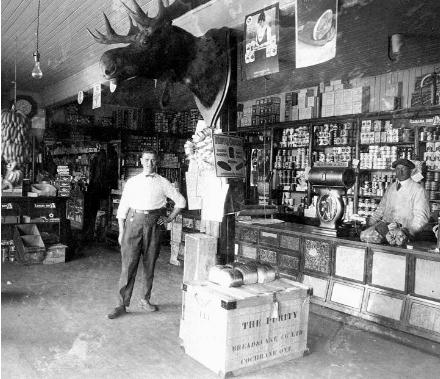
Chalykoff, Drajkoff, & Drajanoff's, about 1920.
Chalykoff & Co: According to the documents, Dimitri's first corporation was dated 1924, namely Chalykoff & Co. – his store in Hearst. The two-storey building, along the west side of 9th Street, stretched from Front to George. They sold groceries, men's, women's and children's wear, farming tools and medication. By the time the whole family moved up to Hearst from Toronto, in the early '30s, the business was well-established. His family lived in the second storey above the store. The apartment was heated and had running water.
It seems that grandfather was a true entrepreneur, catering to all the needs of the erstwhile hapless humans. It is said that during Prohibition, he had barrels of whisky shipped up by train. But, because of watchful eyes, the liquor could not be discharged at the station, so was thrown from the train as it slowed, somewhere near Ryland. Many a time, men had to be conscripted at the last minute to retrieve the goods along the track. Grandfather would describe the whisky in the little glass beside his plate at suppertime as his medicine.
While sitting on a wooden bench in the store, I remember Grandpa opening a small barrel of raw oysters, shucking them, and teaching me how to swallow them whole. I also recall Mr. Lafond, the store's butcher, in his red-stained apron, handing out wieners to hungry children. Wieners tasted much better in those days. The boardwalk in front of the store was my playground.
Romeo Bourdon: Sometime in the '30's, the Ontario government passed a law to the effect that every pharmacy had to be run by a pharmacist. Dimitri sent a letter to the University of Ottawa requesting a list of candidates to fill the post. Romeo Bourdon, of Ste. Rose de Lima, near Ottawa, answered the call. Not only did he become the prominent Hearst pharmacist, he also married Dimitri's daughter, Neda. In the early days of the pharmacy, the mortar and pestle were the tools of the trade. All sorts of ingredients from large jars were ground together into potions that would cure all manner of afflictions. The mass-production of penicillin during the war years in the '40s no doubt facilitated the task of dispensing medication. The Bourdon family lived in a house on Kitchener Street. Romeo and Neda had five children. Jeanne named for Romeo's sister, Jacqueline, Robert, Carole, and Hélène. They were Roman Catholic, a religion I knew well from my school days in Calstock, and was not unhappy to join them when they went to mass. I found the original church to be quite interesting with all the statues of biblical personae, quite unlike our bland United Church.
The Wades: After the Depression, another family moved to Hearst, the Wades, Abel and Annie May, and most of their grown children from Sault Ste. Marie. Herbert, the youngest son, came up from London, Ontario, after a stint working for the Royal Bank. The young Wades and Chalykoffs were good friends and spent time together picnicking and playing tennis and ball. Mother said that in those days courting couples always had to have a chaperone present. In spite of that, Sanna Chalykoff and Herbert fell in love and on married September 14, 1936. See Wade story in Clayton's Kids.
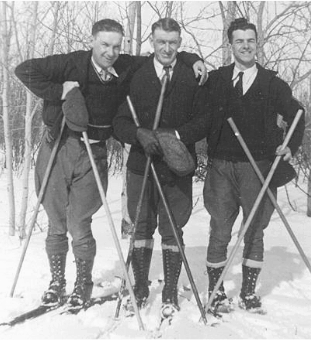
Bob Mäki, George Banks, Rod Chalykoff, early 1930s.
Rod & Hazel Chalykoff: Hailing from Brampton came the lovely Hazel Wanless, having been lured by her friend, Dr. Margaret Arkinstall, to work as the dietician at St. Paul's Missionary Hospital. After being in Hearst for a short time, Hazel had decided not to stay; however, one evening she happened upon a concert at the school and heard Rod Chalykoff sing. She unpacked [as related by her daughter, Judi]. Hazel and Rod were married and had a son, Ted.
Back in high school, Rod had joined the cadets, so after September 1, 1939, when Hitler attacked Poland and World War II broke out, he enlisted in the Royal Regiment. He unfortunately was part of the military debacle that took place on the beaches of Dieppe, on August 19, 1942. Being among the third wave of the landing, he survived and was among the 1,874 Canadian troops captured that day. The telegram from the Canadian military read that he was missing in action and presumed dead. The family feared the worst. I was told that when Hazel was given this terrible news, her hair turned white. Uncle Nick, Rod's brother, told me that during this time, night after night when their mother went to bed she could be heard weeping. At the time of his capture, Uncle Rod was given the choice of going to a concentration camp or working on a farm. He wisely chose the farm, calculating his chance of survival would be greater with food available. Unfortunately, the farm was in Poland, a considerable march from Dieppe. Uncle Rod spoke very little of that time. Once, when I balked at eating every morsel on my plate, he told me that I was fortunate to have food, because as a prisoner, he was lucky to have potato peels to eat.
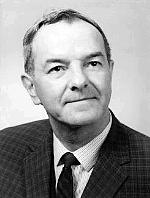
Rod Chalykoff.
Years later at a going-away party for a World War II veteran, George Ponting, I asked him about his experiences during the war. He described how he had been taken prisoner at Dieppe, marched to Poland to work on a farm. I told him that my uncle Rod had had the same experience. George asked if his name was Charley something! You bet! George related a story of how they would collect bits of bread with which to create a path of crumbs from the chicken coop to their hut. When a chicken ate its way to the hut it was quickly dispatched to the pot.
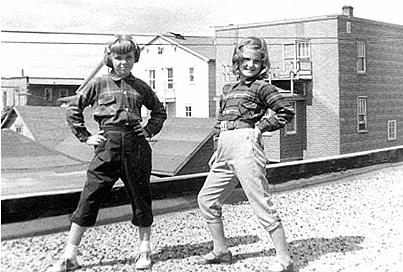
Peggy Mills and Judi Chalykoff on flat roof of store.
In the early 1950s, Uncle Rod brought his family, now including daughter Judith, back to live in Hearst. Rod and Hazel took over the men's and women's wear departments of Chalykoff's store. I remember Aunt Hazel attending evening French classes; even then, it was important to speak both languages in Hearst. Aunt Hazel was always beautifully attired and groomed, her lovely white hair delicately rinsed with blue. Looking back, I think she was a woman ahead of her time. She had great business acumen, a wonderful sense of humour and was very kind. One day I was in the store looking for something to wear to the High School Christmas Dance and couldn't find anything I liked. Next day, she called and offered me this beautiful navy blue taffeta, shawl-collared dress. If I liked it, it was mine. I did like the dress and wore it often. Every evening after supper, Hazel would walk and sometimes I would join her. If you are going to eat, you have to exercise, she would say. Rod and Hazel moved back to Toronto to live out their final days.
Epilogue: Dimitri, Neda and their children are all gone now. We remember them with admiration and pride for their courage and perseverance in making lives for themselves and their families in the frozen north, through the pioneering years, the tough Depression and World War II. We miss them and salute them . . . wherever they are.
Editor's Note: Chalykoff was the name taken by Dimitri and Todor because the Bulgarian pronunciation of their surname could not be anglicized. Any Chalykoffs in North America are their descendants.